What Is Peyronie’s Disease?
Peyronie’s disease is a term universally used to describe a condition where a man’s penis bends significantly when erect. It gets that name from the French surgeon who described it in 1743, Francois Gigot de La Peyronie.
However, there’s a big difference between full-scale Peyronie’s and pre-Peyronie’s.
Pre-Peyronie’s Disease
Pre-Peyronie’s disease is identified by fibrous plaque in the penis that causes noticeable curvature during an erection. Depending on where the plaque buildup is, the penis may be curved to the side, downwards, or upwards.
Not every case of pre-Peyronie’s evolves into full-scale Peyronie’s – but the chance for such deterioration increases exponentially because of the higher likelihood of penile trauma because of the abnormal curve.
The difference between pre-Peyronie’s and full-scale Peyronie’s is usually determined by identification of scar tissue that resulted from intensive stress in an already curved, plaque-filled penis present in pre-Peyronie’s.
Signs of Full-Fledged Peyronie’s Disease: What Does PD Look Like?
Full-fledged Peyronie’s disease usually includes scar tissue characterized by increasingly hardened plaque or a hard lump that occurs on the penis. It begins as a localized inflammation, which progresses to a hardened scar on the shaft of the penis that reduces flexibility and causes the penis to bend more intently during erection.
This may cause pain on erection and a deformity that may prevent sexual intercourse altogether. Aside from the physical consequences, depression and loss of self-esteem are common in men with Peyronie’s disease.
Plaque: The Men’s Health Nightmare
The buildup of both calcified and fibrous plaque in the penis is the most common underlying culprit for symptoms of Peyronie’s disease. Most people first develop an awareness of the problems associated with plaque from cardiology: that arterial “blockage” we hear commonly associated with the risk of heart attack? That’s calcified and fibrous plaque clogging up your arteries. Also, such plaque is the root cause for Alzheimer’s disease where neurotoxic amyloid plaques clump into thick, insoluble masses and disrupt the transportation of essential materials such as nutrients and organelles to the brain – adversely affecting memory function. Plaque is the bane of long-term human health. The penis – being an organ whose primary function is derived from blood flow – is obviously a natural victim for of this calcified killer.Peyronie’s Disease Treatment Methods
If you Google “Peyronie’s Treatment,” the search results can make it seem fairly painless to rectify. You’ll discover countless options and many will sound easy, even simple. Sadly, that’s not the case. Peyronie’s Disease is named after the French scientist who first identified it in 1743. For clarity’s sake – that was thirty-three years before the United States officially became a country! Since that time there’s been little developed that relieves acute cases of Peyronie’s disease.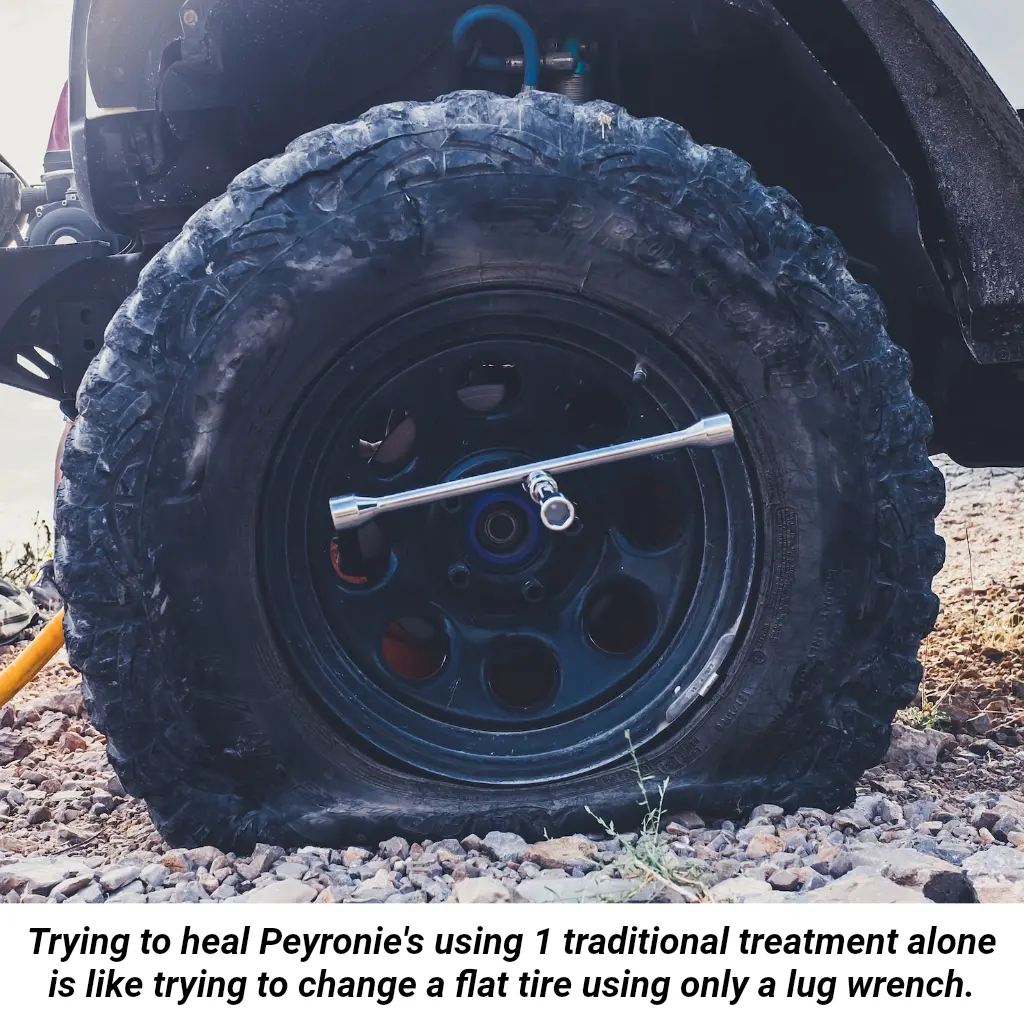
What Doesn’t Work Healing Peyronie’s Disease?
One of the most heart-breaking aspects of our jobs at the clinic is hearing horror stories about how much time and money our patients previously invested in useless efforts to heal their Peyronie’s disease. Ironically, some of those treatments – like Xiaflex® and shockwave therapy – do play a role in healing select cases.
However, these treatments by themselves?
The treatments used in isolation is like trying to change a flat tire with only a lug wrench. They just can’t address the whole situation on their own, let alone the myriad of unique patient circumstances facing this condition.
Even more sadly, some of these patients were actually made worse by such treatments, particularly when they were repeated after initial failures.
Historical Treatments of Peyronie’s Disease
A wide variety of treatments have been used over the years in an attempt to arrest the pain and symptoms associated with Peyronie’s disease with limited success. These treatments include: radiation, verapamil, collagenase (Xiaflex®), interferons, traction devices, iontophoresis, surgery, implants, plus varied topical applications, vitamin E, and herbal remedies.Peyronie’s Injectable Treatments
Verapamil is a Non-Dihydropyridine calcium channel blocker and is one of the most popular treatments; it’s injected directly into the plaque buildup in the penis. Essentially, it helps soften this plaque in hopes of breaking it down. Unfortunately, it’s just not strong enough to effectively treat anything but the mildest beginning cases. Collagenase is another popular injectable method most commonly recognized under the trade name Xiaflex®. Xiaflex® is expensive ($23,000-$28,000) and only ever approved for insurance reimbursement when the curve is greater than 30 degrees.Xiaflex® Drawbacks
Xiaflex® injectables face a number of important limitations:
1. Xiaflex® doesn’t remove built-up plaque
Even if Xiaflex® is successful in unbending the curve of Peyronie’s disease through scar tissue dissolution, the patient will often still suffer from a shorter, morphed penis full of varied plaque.
2. Xiaflex® can’t be injected into calcified plaque
Xiaflex® is unable to penetrate the calcified plaque commonly found in patients with a curve in the penis in excess of thirty degrees.
If used in such cases, the powerful acidic solution usually drains around that impenetrable barrier and seeps into the corpus cavernosum – the sponge-like functional sector of the penis responsible for erection. This seepage can result in permanent impotence for the patient.
3. It can’t be used to treat the underside of the penis
If the source of the bend is located on the underside of the penis, Xiaflex® can’t be used because of the likelihood of damaging the urethra.
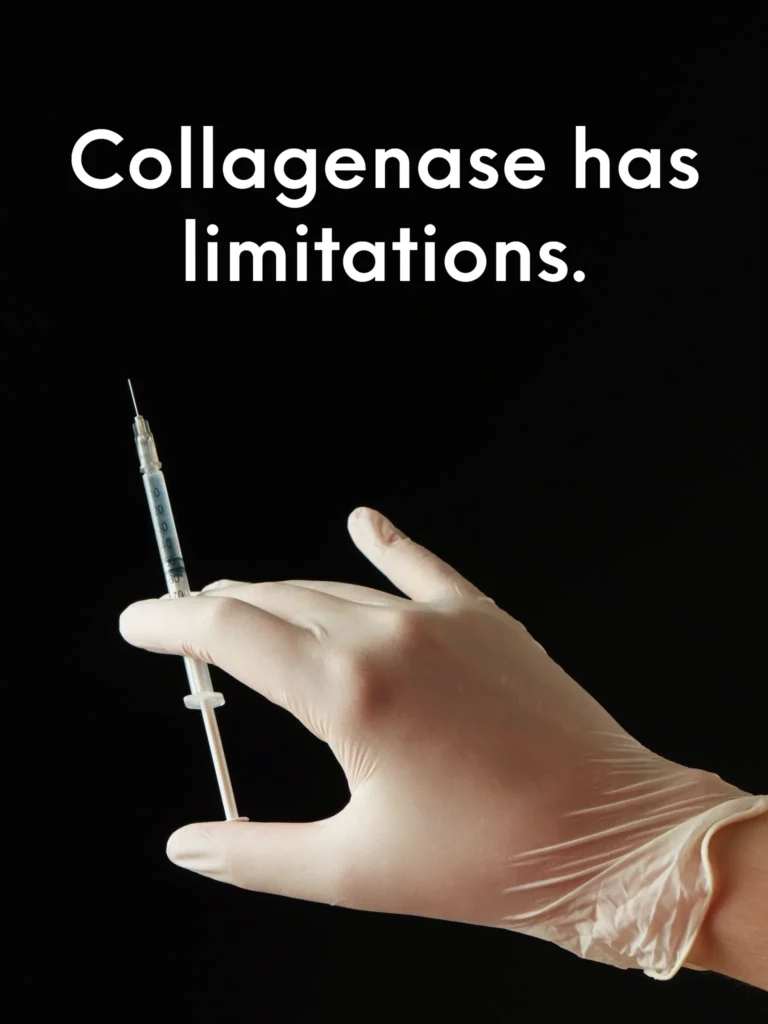
Shockwave Therapy for Healing Peyronie’s Disease
We were one of the very first pioneers to use shockwave therapy for men’s health over ten years ago.
It’s an absolutely amazing technology that we believe will leverage several game changing outcomes in many aspects of healthcare.
However, by itself – it’s only as effective healing Peyronie’s disease as trying to change a flat tire with only a lug wrench. You’re going to need it to succeed but you won’t get any real progress without the other essential tools.
Use of Shockwave Therapy in Helping Break up Plaque in Peyronie’s Cases
Shockwave therapy has never been shown through any verifiable results or our own decade-long experience with low intensity shockwave (LISW) treatments to provide any success breaking up plaque associated with Peyronie’s disease.
That’s why none of the shockwave device manufacturers make any such claim as the FDA requires proof of any such claim by manufacturers. Unfortunately, the FDA doesn’t inhibit what practitioners can say what outcomes they think they might cause – which is why you hear so many ads talking about using shockwave therapy to repair Peyronie’s disease.
What’s most absurd is trying to treat such plaque without the guidance of a detailed penile Doppler analysis. Without that objective analysis you can’t objectively measure progress or failure. You can’t palpate diffuse plaque within the corpus with fingers or manage rates of required blood flow with a space-age stethoscope. Neither the doctor or patient has an objective means of measuring improvement.
Attempting to heal Peyronie’s without using a detailed Penile Doppler as a yardstick is like trying to hit a bullseye with a blindfold on.
Such approaches are ridiculous and wishful thinking at best.
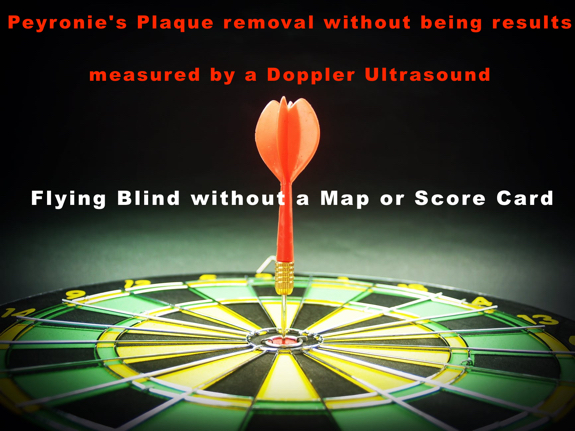
PRP Injections Effectiveness in Healing Peyronie’s Disease
The reason PRP shots are ineffective for the penis was proven from years of research shared by Dr. Tom Lue during a keynote address at the 2016 American Urology Association convention in San Diego.
Dr. Lue is considered the nation’s foremost academic researcher in urology and invested over two years trying to improve regenerative cell treatments for penile healing technologies.
Dr. Lue is also considered the nation’s foremost academic Peyronie’s researcher. He’s a professor, Vice Chair of Urology, and serves as medical director of Knuppe Molecular Urology Laboratory at University of California, San Francisco. Dr. Lue remains actively involved in basic and clinical research in erectile dysfunction, priapism, Peyronie’s disease, and urinary incontinence after working in the space for more than 30 years.
Dr. Lue invested over two years trying to make every known variety of regenerative cell harvest and injections work in healing the disease.
He ended up discovering it didn’t work because of the unique, powerful rates of blood flow in the penis (second only to the human heart in force). He detected that 98% of all injected cells were completely gone from the penis within 24 hours and 99% were gone in 48 hours.
Thus, these cells never have a chance to perform like they do in a knee or a shoulder. Worse still? He discovered those cells migrate to the closest tumor and cause it to grow at an alarming rate.
It was after this discovery that almost every urologist in the country quit performing PRP injections.
Shockwave Therapy With PRP Injections to Fix Peyronie’s
Shockwave therapy by itself doesn’t break up plaque or heal Peyronie’s disease, and PRP injections are proven to be of no value.
Putting the two together? It’s going from bad to worse.
The only measurable outcome is it spends your money even faster on something that doesn’t improve your condition.
Revolutionary New Peyronie’s Disease Treatment
The good news?
That situation is about to change.
After twenty years of research and development focused on nothing but healing Peyronie’s disease we’re proud to announce we can provide measurable improvement in curvature in virtually every case presented.
The latest treatments for Peyronie’s disease are performed at Morganstern Medical. The therapy program is called ExoSurge™ and it’s currently only available in Atlanta. The devices used to stimulate healing are expensive, the protocols associated with care are proprietary, and we patent-protected the combined processes. We expect our technology to be available to everyone by 2027.
Here are a few highlights of what ExoSurge™ can do to heal Peyronie’s disease:
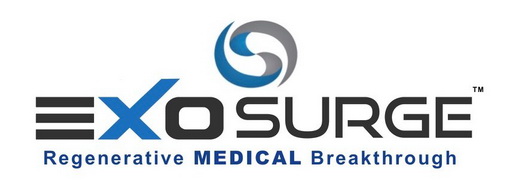
- Heals the symptoms of Peyronie’s disease
- Disseminates fibrous and calcified plaque
- Straightens your curved penile shaft
- Restores healthy penile function and sensation
- Available exclusively at Morganstern Medical
Peyronie’s Disease Treatment Cost
The downside? It’s expensive.
The average is now $16,000 in out-of-pocket expenses since it’s still considered experimental and little is covered by health insurance. It’s also time consuming – the process usually take months of repeated treatments before complete plaque removal is achieved.
Success Rates of Latest Peyronie’s Treatment
The results are completely quantifiable as your case progresses through repeat vascular studies that show the exact improvements in various blood flow rates and destruction of plaque that causes curvature or “hardness” you feel in your unit.
Once we clear it up? It’s gone for life – unless you somehow reinjured your penis!
We’ve now successfully healed over 1,000 Peyronie’s disease cases and we’re continuing to tweak the process to make it even better. Also, if you can’t afford treatments or are unable to travel to our flagship clinic in Atlanta GA for healing: please don’t lose hope!
We have a full-time team exclusively dedicated to driving the next steps where our breakthrough will be available nationally and internationally (and hopefully completely covered by traditional health insurance!) in future years, about 2026-2027.
How to Cure Peyronie’s Disease
To fully understand how Peyronie’s gets cured, it’s helpful to go back over 25 years ago when our founding physician first decided to make Peyronie’s Disease his life’s work.
In the mid 1990’s, Steven L. Morganstern, MD was one of America’s most renowned physicians treating erectile dysfunction.
He was one of the first to implement pellet testosterone replacement therapy. He was a pioneer with prosthetic penile implants, chosen by AMS (the original inventor of penile implants) to train all other urologists on implant surgical procedures for the first three years of that product’s launch.
He authored three best-selling books on men’s sexual health and was chosen as the only private clinic to be included in the original trials for Viagra.
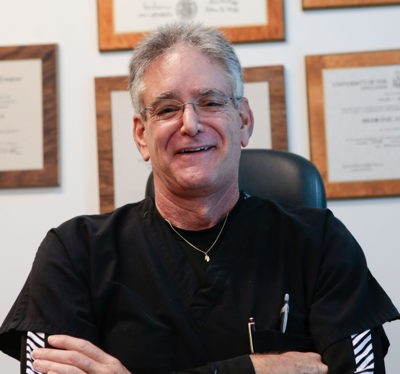
Then, in 1993 while he was at the very top of his game in the erectile dysfunction world, he encountered a series of three patients with severe Peyronie’s – one a dear life-long friend. Every one of these patients was suicidal – contemplating ending their life rather than continue to try and deal with all the negative impacts of this devastating diagnosis.
It was at this moment Dr. Morganstern began to shift almost all his focus to developing a new way to heal Peyronie’s disease. He tried surgeries but felt they did nothing more than mechanically repair the curve but leave the underlying disease in place – causing recurrence, or worse. This assumption was later confirmed by a decade long retrospective surgical case study: Wimpissinger, 2012
He tried and tested every known or recognized methodology for treating Peyronie’s – to no avail.
It was just after the year 2000 that Dr. Morganstern began exploring an idea that would be key to healing this most challenging condition.
It began by asking one simple question: Why?
What was it in the 13% of men (we call them “The LUCKY 13”), who get a Peyronie’s diagnosis and the condition simply “goes away.” What made them different than the remaining 87% stuck with this life-long debilitating disease which progressively gets worse?
To find those answers he had to cultivate a study of men whose bodies had naturally healed the condition and compare that to another group that ended up with a Peyronie’s diagnosis from essentially the same circumstances. This project took three years of intensive patient research.
During 2004, Dr. Morganstern finalized a list of 13 measurable variations and optimal Peyronie’s health targets that were to be tested, evaluated, and enhanced for the largest number of Peyronie’s patients to have the same sort of healing dynamics that existed within “The Lucky 13 Patients.“
Even with the building blocks of his Peyronie’s healing algorithm in hand, Dr. Morganstern was still miles away from being able to deliver a solution to his patients. What was the biggest remaining roadblock to developing a solution that could cure Peyronie’s disease?
He had to find a safe way to precisely stimulate numerous arterial vascular flows in a far more powerful manner than mother nature provided “The Lucky 13” since those patients’ natural healing ability would only be strong enough to treat immediate cases. Most men go months before realizing that they’re dealing with Peyronie’s, and many are in more advanced stages with plaque and fibrosis far beyond initial stages of the disease.
That later caveat was a tall order. Dr. Morganstern openly admits he nearly abandoned this work more than once during the long, ten-year stretch he spent finding, evaluating, researching, and testing various stimulation therapies.
Even after he finally unearthed a suitable tandem of devices to augment healing, it took another three years to refine the related injectables and supporting protocols and comprehensive algorithms that would successfully remove penile fibrosis and plaque without surgery.
In 2016, after successfully treating and healing over 100 patients with Peyronie’s Disease using this new therapeutic technology, Dr. Morganstern filed for patent protection of his proprietary methodologies.
Having recently turned seventy-two years old, Dr. Morganstern is not nearly as active seeing patients in clinic as before. However, he still reviews the case files on each patient with his team of ExoSurge™-certified providers.
Aside from treating and healing a steady flow of patients from around the globe at our flagship clinic in Atlanta, our team is presently focused upon:
- Testing a pair of new treatments in an effort to find a safe and faster solution for the decimation of large pieces of calcified penile plaque.
- Working on projects related to our pathway for FDA approval and universal availability of ExoSurge™.
How does ExoSurge™ fix Peyronie’s disease?
Now that you know where it came from, let’s educate you on how we do it.
First, a few basics:
- Every Peyronie’s case is unique. There’s not a single Peyronie’s diagnosis that’s identical to another guy’s in the world.
- Nothing about healing Peyronie’s here is a “guessing game.” Results are completely measurable through repeat vascular studies on the penis.
There are 5 key aspects that must be thoroughly evaluated in order to prepare a workable healing plan for each case. These key conditions include:
1. The degree of blood flow coming into the penis
2. The blood flow rates throughout the penis
3. The magnitude of peripheral blood flow throughout the patient’s body
4. The quality of penile tissue vascularization and extent of any venous leakage
5. The size, location, and nature of any and all fibrosis / plaque within the penis
6. The levels of the 6 macronutrients essential to healing Peyronie’s disease
Some guys are blessed – we call them The Almost Lucky 13. What we mean by that is that after testing we discover their physiology is just short of having been amongst the group where this condition would have healed itself.
Their pathway to success is usually pretty easy unless the plaque has been long established and has become calcified. They are also the reason we sometimes hear about guys having this condition go away with just a few injectables, a stretching device, and a few supplements.

These essential healing parameters are revealed by three tests, plus a patient health and case history collected during a clinic visit. Once we have all that data and have a chance to evaluate it, we can map out a solution and educate the patient in resolving the disease.
What are the three tests we perform to map each case?
- MacroSurge
- StemXSurge
- EndoSurge
| Test Performed | What does this procedure test for? | What are the results of this procedure used for? |
| Blood Work | Analyzes blood components looking at the presence of various Macronutrients and in what quantity they present themselves in your body. | Sometimes our bodies have the bare minimum macronutrients to function from. This test allows us to check these numbers and supplement what is needed to get the body into optimal operational and healing range prior to treatment. |
| Vascular Study | Looks at the blood flow of the penis. Measures the ability of the penis to retain blood. Checks for any plaque or calcification buildup in the penis. *This may reveal the need for any combination of the treatments* | If blood flow is poor in or to the penis then a treatment pertaining to increasing blood flow may be required. (RejuvaHeart™) |
| If flow is not retained in the penis then a treatment pertaining to increasing blood retention will be required. (Neosonic™) | ||
| If there is plaque of calcification in the penis then the treatment for breaking down this plaque and calcification is required. (EndoStim™) | ||
Endograph *if blood flow from the Vascular is inconsistent or sporadic* | Looks at the stiffness and functional age of the blood vessels through the body. | This gives a better indication of whether the low/sporadic blood flow in the penis is an isolated situation or across the entire body. If it is not isolated then a treatment pertaining to increasing blood flow is required. (RejuvaHeart™) |
After all your testing is complete, our certified ExoSurge™ provider will review specifics of your case in detail with you.
At present, there are three different device-based treatment models we use to stimulate your healing and breakup of the penile plaque. Which we use depends upon the results of your testing. Additionally, we will usually need to supplement you to a very specific level on six different macronutrients.
How do you cure Peyronie’s disease without surgery?
ExoSurge™ is a non-surgical, non-invasive, proprietary new process that breaks down the diffuse plaque and/or plaque mass associated with Peyronie’s disease while rehabilitating the inner tissue essential to function and performance. Finally there is a non-surgical treatment to successfully address a curved penile shaft.
ExoSurge™ attacks your condition from both a macro and micro basis: we work to reduce or eliminate the plaque that’s already flowing through your tissues and create a basis for the body to assist in your recovery process.
Additionally, we use a particular type of low intensity shockwave plus customized carboxy therapy injections along with electronic counter pulsation. Each of these Peyronie’s disease treatments serves a purpose absolutely necessary for healing the curve in your penis, including:
How Penis Curvature Is Corrected
- Gently breaking up the plaque in the penis that serves as the ugly foundation for which penis curvature is built upon
- Rehabilitating and healing the underlying penile tissue found in the corpus cavernosum – it’s almost always damaged when you experience Peyronie’s conditions. What’s the point of fixing the curve if the performing tissue won’t work well afterwards?
- Drug Injections: Verapamil treatments are also often used during the plaque decimation process. Xiaflex® can be effective in select cases to finalize success with straightening penis curvature after the underlying plaque is resolved.
ExoSurge™ Does More Than Dissolve Plaque: It Revitalizes Penile Tissue
While the decimation of plaque is the most compelling outcome from ExoSurge™ the technology does even more: it also revitalizes penile tissue by creating improved blood flow and cell rejuvenation.
How does it do that?
Imagine a young penis as a brand new sponge. Over time as it gets used, the sponge becomes dry, hardened, and unable to hold water as before.
Guess what? This imagery is exactly what happens to an aging penis.
The inner tissue that serves as the basis for an erection looks and acts like a sponge. If you don’t revitalize that tissue as you straighten the curve? You end up with a sponge that only looks better; it still won’t function as it did before the disease.
While one aspect of the treatments dissolve the plaque associated with Peyronie’s disease – the other aspects are softening and revitalizing that aging sponge-like tissue.
Penile Curvature Improvement is Easily Measured
 Before we start every ExoSurge™ regimen, we complete a comprehensive vascular study that details your present circumstances regarding plaque and curvature. For more extreme cases with significant buildup of calcified plaque, you’ll be able to accurately gauge your progress with subsequent vascular analysis.
Before we start every ExoSurge™ regimen, we complete a comprehensive vascular study that details your present circumstances regarding plaque and curvature. For more extreme cases with significant buildup of calcified plaque, you’ll be able to accurately gauge your progress with subsequent vascular analysis.
This isn’t a guessing game.
When we remove the calcified and fibrous plaque? Complete healing is possible in every instance.
ExoSurge™ is a Non-Surgical Solution
The entire ExoSurge™ treatment process is non-invasive and non-surgical. All treatments are performed in-office and result in minimal pain or swelling. For patients with enough time to invest, we can escalate the daily and weekly process to achieve more rapid results.
